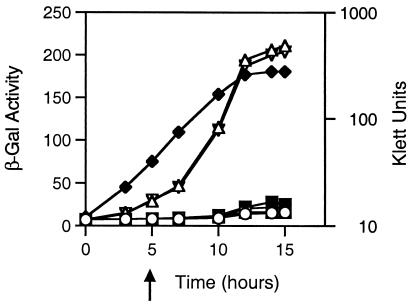FIG. 5.
TraR retains in situ activity after removal of the 3-oxo-acyl-HSL quormones. Cultures of E. coli DH5α(pPBL1, pZLQ), which lacks traR, and of E. coli DH5α(pPBL1, pZLQR), which expresses traR, were grown in A medium to a density of about 107 CFU/ml as determined by Klett colorimetry (♦, red filter). At time zero, IPTG (100 μM) was added to induce expression of traR in DH5α(pPBL1, pZLQR), and the two cultures were split into two and three subcultures, respectively. After 1 h of incubation, 3-oxo-C8-HSL (25 nM) (□) or 3-oxo-C6-HSL (100 nM) [▿, DH5α(pPBL1, pZLQ); ○, DH5α(pPBL1, pZLQR)] was added. One subculture of DH5α(pPBL1, pZLQR) received no quormone (▵). After 4 h of reincubation (arrow), cultures of DH5α(pPBL1, pZLQR) that were grown with a quormone were harvested and washed extensively as described in Materials and Methods, and each culture was further split into two subcultures, both of which lacked IPTG. 3-Oxo-C8-HSL (25 nM, □) or 3-oxo-C6-HSL (100 nM, ○) was added to one such washed subculture, and an equal volume of sterile water was added to the second (▪, •). The cultures were reincubated, and samples were taken from each culture at the indicated times and assayed for β-galactosidase activity. The experiment was repeated twice; the results from one experiment are shown.

